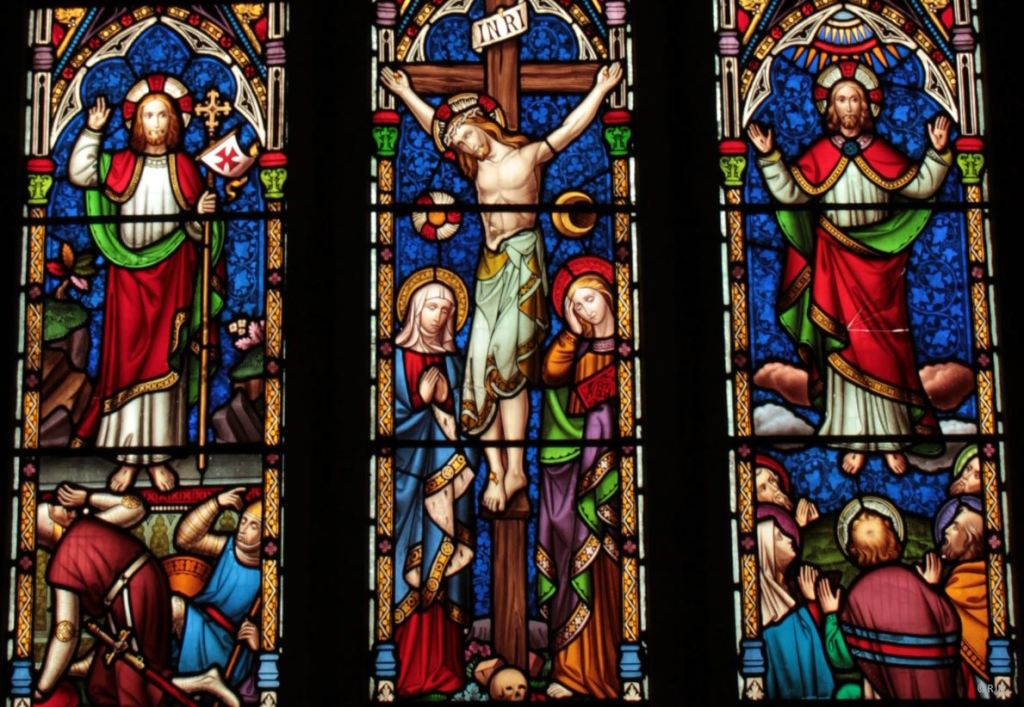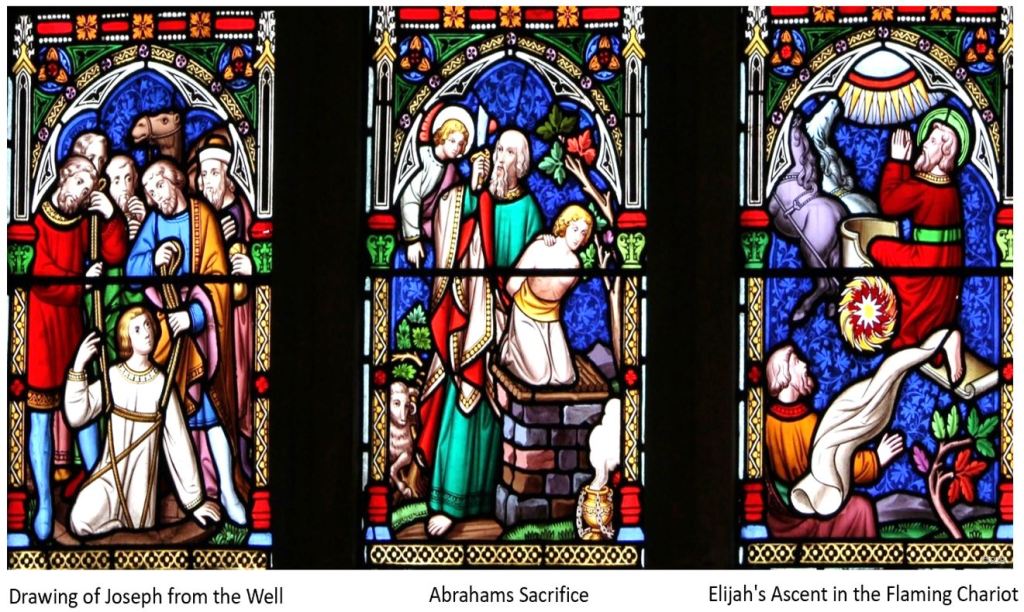#
Artist/Studio: William Wailes, Newcastle-upon-Tyne, England.
Year: 1862.
Location: South Hobart, Tasmania, Australia
Building: All Saints Anglican Church, Macquarie Street.
Memorial: N/A
Donor: Alfred Kennerley and a Church Warden.
Photos dated: 11th August 2010, R.J. Brown.
Tasmania’s famous colonial architect Henry George Hunter designed All Saints in the Pugin style and it was built by contractor James Dickinson[1]. The foundation stone was laid on the 2nd of December 1858 by the Governor of Tasmania, Sir Henry Young [2] and it was opened 18th August 1859[3]
There are many historical stained-glass windows in All Saints’, some of which have a direct link to my family history in relation to the Ferguson & Urie stained glass company of North Melbourne but the provenance of many other windows seems to have been lost in translation over a century and a half. As recent as a decade ago it was claimed that all the windows in All Saints’ were by Ferguson & Urie. After personally seeing the windows back in October 2010 I could only confirm the provenance of Ferguson & Urie windows which are all on the liturgical north side. None of the others remotely looked like the work of Ferguson & Urie. Based on significant differences in artistic styles, it looked like there were at least another two distinctly different stained-glass studios involved in the windows and they were not of Australian manufacture!
Between 2010 and 2019 I did very little research of other windows at All Saint’s as my primary focus was on the work of Ferguson & Urie but in 2012 I did find the evidence of two other stained-glass studios involved. My friend Gavin Merrington, Tasmania’s heritage stained glass craftsman, was commissioned to do some restoration work on many of the church windows. The first window to be taken out was to be the liturgical west window. There was going to be some media and political fanfare about the restoration of the All Saint’s windows and they were going to be present when Gavin was removing the window, so I thought it would be great to at least find some evidence to prove who the maker was. I eventually found was that it was imported from England by the ship “Broadwater” from the studio of Charles Clutterbuck in 1864. Another window, the John Page memorial in the liturgical south wall was by the English firm of William Wailes circa 1869.
One set of windows at All Saint’s had me perplexed for many years. As recent as June 2022 it was still claimed that the chancel windows of All Saints’ were the work of Ferguson & Urie of North Melbourne.[4] My first impression back in 2010 was that these windows were most likely to be the work of William Wailes of England. Nearly all of the windows along the liturgical south wall (facing Macquarie Street) looked like they were the work of Wailes and amongst my photograph collection of other Wailes windows there is a three light Crucifixion window of similar design at Christ Church, Hawthorn, Victoria. It represents a very significant window for use as a comparison with the Crucifixion window of All Saints and this certainly swayed my opinion to stick with an attribution to William Wailes for the All Saints’ chancel windows.
A decade ago on-line research evidence was very thin. At the time no other documentary evidence was available to prove any attribution of the All Saints’ chancel windows to William Wailes. The National Archives digitisation of historic Australian Newspapers (TROVE) was relatively new at the time and there still isn’t anything in TROVE that corroborates it.
In April 2019 I eventually found an obscure reference to stained-glass at All Saint’s in the Stilwell Index (Allport Library Tasmania). The index entry was dated June 1862 which preceded the Charles Clutterbuck window in the liturgical west wall from 1864 and all the Ferguson & Urie windows along the liturgical north side from circa 1868.
After obtaining the elusive tabloid article from the Hobart Town Advertiser of 1862 it confirmed that the chancel windows were imported from England from the studio of William Wailes, England
The triple light window directly behind the altar depicts the Resurrection, Crucifixion and Ascension and the flanking single lights depict the apostles St Paul & St John. The designs for the windows were selected by the Rev Tice Gellibrand and were executed by the English firm of William Wailes of Newcastle -Upon-Tyne, England. These were the very first stained-glass windows to be erected in All Saint’s and were donated by the Mayor of Hobart, The Hon Alfred Kennerley.
The Hobart Town Advertiser from 1862 contained the necessary provenance to firmly attribute the chancel windows to William Wailes and it contained an extraordinary amount of information about what was depicted in the windows.
“…The glass is from the manufactory of Wailes of Newcastle, and is decidedly the best specimen of this beautiful art we have yet had the pleasure of seeing in the colony…” [5]
“…In the East window, which consists of three lights, divided by stone mullions with traceried head, are represented the following subjects: – “The Crucifixion of our Lord,” in the centre, with “Abraham’s Sacrifice” underneath. In the side lights are the “Resurrection from the dead” with the “Drawing of Joseph from the Well,” and the “Ascension of Our Lord,” with “Elijah’s Ascent in the ‘Flaming Chariot.'” Three of the tre-foils in the head are filled with ornaments, devices and diapering with the Alpha and Omega. Two quatre-foils have Angels bearing the Instruments of Passion, on a beautiful deep azure ground. The centre opening of the tracery in the head is filled with Agnus Dei.

In the two smaller windows on either side of the chancel are given full-length figures of St. John and St Paul on richly diapered grounds, having enriched canopies over the niches in which the figures are represented standing…” [6]

Starting from the tracery windows at the top of the Crucifixion window in the chancel is the Agnus Dei or Lamb of God carrying the victory banner. Below this are two angels carrying the instruments of the passion (the wicked weapons used in nailing him to the cross and tormenting him to His death). On the left, the Angel carry’s Christs Cross with His Crown of Thorns and the Three Nails used to affix Him to the Cross. On the right an angel carry’s the spear that Christ was pierced with on the Cross and a staff with the Holy Sponge on the end. Below the angels are three trefoils in Gothic floral designs which include vine leaves and grapes. The outer two trefoils contain, on the left, the lettering ‘A.O’ representing Alpha and Omega (the beginning and the end). The right trefoil contains the letters ‘I.H.S” an abbreviation for ‘IHESUS,’ the way Christ’s Name was spelled in the Middle Ages.

The central scenes in the window depict three events surrounding Christs Crucifixion.

On the left is Christs Resurrection with the sleeping soldiers at the base of the tomb.
The centre light depicts the Crucifixion. Christ is nailed to the cross and two women weep below.
The right light depicts the Ascension. Christ ascends towards the rays of light of heaven, Clouds are shown at his feet and the men and women watch below in wonder.
The scenes in the bottom third of the windows depict the drawing of Joseph from the well, Abrahams Sacrifice and Elijah’s Ascent in the Flaming Chariot.

These are described in further detail as;
The Drawing of Joseph from the Well.
Genesis 37:28 – This is an Old Testament story that refers to Joseph the most loved son of his father, Israel, given the famous robe of many colours (Joseph’s brothers hated him). “So when the Midianite merchants came by, his brothers pulled Joseph up out of the cistern and sold him for twenty shekels of silver to the Ishmaelites, who took him to Egypt.”
Abrahams Sacrifice.
Hebrews 11-17: God asked Abraham to sacrifice his son Isaac. When God saw that Abraham was willing to do it he said, “do not lay a hand upon the boy”. It meant that God understood that Abraham believed in him: “By faith Abraham, when he was tested, offered up Isaac: and he that had received the promises offered up his only begotten son.”
Elijah’s Ascent in the Flaming Chariot.
2 KINGS 2-11: “And it came to pass, as they still went on, and talked, that, behold, there appeared a chariot of fire, and horses of fire, and parted them both asunder; and Elijah went up by a whirlwind into heaven.”
The centre light of the chancel window was restored by Gavin Merrington circa 2013.
Related articles:
1867: James Urie visits Tasmania on Ferguson and Urie business.
1868: Ferguson & Urie Stained Glass at all Saints South Hobart.
1871: John Page window, All Saints Hobart by William Wailes.
2012: All Saints South Hobart Conservation work.
Footnotes:
[1] The Hobart Town Daily Mercury, Tasmania, Saturday 20th August 1859, page 3.
[2] The Hobart Town daily Mercury, Tasmania, Wednesday 1st December 1858, page 3.
[3] The Hobart Town Daily Mercury, Tasmania, Saturday 20th August 1859, page 3.
[4] All Saints Web Site (accessed 202020)
[5] Hobart Town Advertiser, TAS, 23rd June 1862, page 3, column 1. Para 5.
[6] Hobart Town Advertiser, TAS, 23rd June 1862, page 3.
Short link to this page: https://wp.me/p2yCYO-Gq



Excellent detective work once again Ray on some beautiful and classic Australian heritage glass in a great little church.
Thanks Gavin,
It’s a long time since I last posted an article here on my web site. Hopefully I’ll get the ‘Mojo’ back in action and post more articles soon. Your stained glass work and international knowledge of heritage restoration and conservation techniques means that our stained glass heritage is in very good hands!
Ray